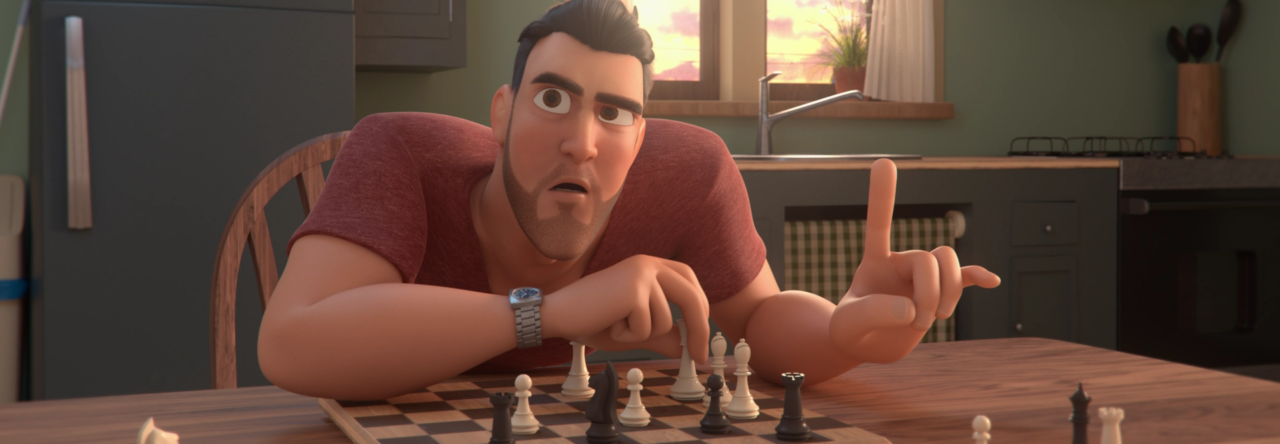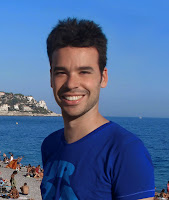We would like to introduce Ricardo Puertas. Ricardo, can you tell us a little about yourself and what animation experience you’ve had before AnimSchool?
For as long as I can remember, drawing, video games and films have fascinated me. So, when I had the opportunity, when I was 17, I started to study Illustration at an Art School.
I had never had drawing or art lessons before, so it was very difficult for me, but I was very grateful to learn. In school I learned much more than before, because in the past I had always taught myself. Those years, I learned so much about my passion of drawing, and I finally had the opportunity to start 2D animation.
After that, I had a course in Animation at the University of Balearic Islands. This gave to me the opportunity to better know the 3D world. In the course they taught us a bit about the process of creating an animation short, so we learned a bit of everything, modeling, rigging, and animation. Then each of us focused on what we were interested in for our final project. Obviously, I decided to go into animation. My final project was selected for several national and international festivals, and I won some awards.
Thanks to that, I had several opportunities to begin my career as an animator, and I finally started to work in a little studio dedicated to making Films and TV Spots. I have been working and enjoying animation for about 7 years. In the last few years, I have mostly been working in video games. Most of time we animate the body, making cycles, transitions, etc. I felt that I needed to improve on the acting of my characters, I was a little rusty in that aspect.
For this reason, I was interested in learning from better professionals of the animation world. I know that this world is a continuous learning cycle. For this reason, I decided to apply to AnimSchool to improve my knowledge in animation hand in hand with great professionals of the animation industry.
Student Ricardo Puertes – Class 4 Body Acting from AnimSchool on Vimeo.
What inspired you to get into animation?
I remember one day when I was 5 years old, while I was having lunch with my grandmother, I saw the Woody Woodpecker show about how to make animation. I liked drawing so much, and this gave me the opportunity to see all these people drawing, and giving life to the characters who fascinated me. At that moment, I said to my grandmother: “Grandma, I want to be an animator.”
What stands out the most to you when you’re watching an animated film?
As an animator, I can’t avoid looking at animator’s timing, poses, etc. I’m always looking and focusing my attention on the character’s movement. I don’t know if this is the best, but I can’t avoid it. After that, when I have the opportunity, I always buy the movies. I can’t stop myself from watching some scenes hundreds of times. I go frame by frame to see how it’s done. I love it!
Student Ricardo Puertas – Class 6 Facial Performance from AnimSchool on Vimeo.
With every AnimSchool test comes new challenges. Out of all the tests you’ve done, which one has been the most challenging and why?
The most difficult part for me was my beginning with lip sync. In video games, most of time, we’re animating the body, making cycles, transitions etc. Some times we get to animate the face, but I never had the opportunity to go too far with facial animation in TV or film. So, when I started my facial assignment, I was really exited to learn and go further with my character.
Can you talk a little about your process for your Facial Performance class shot, from selecting the dialogue to polish?
It was a lot of fun. The most important thing to me at this time was to enjoy the assignment, so I wanted to select funny audio to work with to have fun all term.
All the pre-production was really fun: sketching, searching for and making video reference… this was crazy. But, the most important thing for me was to enjoy it. When I had my sketches, planning and references ready to start, all went easy.
To begin with the blocking, it is very important to have a clear idea. You have to keep in mind all key poses. In this aspect, I had it in my mind from the beginning. In this process I needed to make some changes and to adjust the timing, obviously. But once timed, I passed into splining and it was simple enough to fit and polish the rest.
It’s very important to spend your time in good planning. You can save a lot of work.
What is your favorite part to work on within your process, why?
Obviously, all the phases are a lot of fun. The searching of ideas, the first sketches, when you start the blocking and you can see how your character starts to become alive… But, I think that the best part is polishing your shot, because you can play around and add the little spark of life to your characters.
Student Ricardo Puertas – Class 7 Animating Appeal And Entertainment from AnimSchool on Vimeo.
How has your experience been at AnimSchool? What is your favorite thing you’ve learned?
First, I want to thank all my teachers, Anthea, Mike, Tim, Tony, Stewart and JP, and all the teachers and people who make AnimSchool possible. Especially Dave, for creating this fantastic school. Many people haven’t had the opportunity to learn animation in their city, and thanks to AnimSchool, they’re making their dreams come true. I want to give thanks to my wife too, for supporting me from the beginning in all of this, and my baby, for always being there laughing at his father while I’m recording video reference.
To me, applying to AnimSchool has been one of the best decisions that I’ve made recently. I’ve learned many things each term, but I think in the beginning, I learned a great important thing that I’ve used in every term. In Term 2, with Anthea Kerou, she taught us that the most important thing is that the character, as simple as it can be, has to always, always, always, have one story that motivates him to do what he does in the shot.
What advice would you give to students just starting out?
For the people who are starting in the world of animation, I would say to them that they should be persevering in their work, and go forward. Do not be afraid to show your work to other people, this is very useful. Sometimes you spend many hours working on a shot and it’s not possible for you to see some issues by yourself; other people can indicate those to you.
When someone gives you a critique, this isn’t a bad thing, quite the opposite. It’s the best thing that can happen to you, because you always learn new things from your mistakes. Another thing is, you should keep your eyes open and look at the world with “animator eyes.” 😉






















